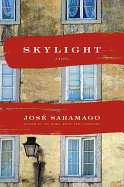
Completed in 1953 when José Saramago was barely in his 30s, the manuscript for Skylight disappeared into the reject pile at a Portuguese publishing house. Crushed, Saramago wrote nothing more for 20 years. Only in 1989, once Saramago had resumed writing and become famous, was the single copy rediscovered. He refused to allow Skylight to be published in his lifetime. It has become the Nobel laureate's posthumous gift, and it's a literary explosion of youthful talent. The story unfolds in the Lisbon of the early 1950s, under the Salazar dictatorship. The opening chapter alone is a bravura performance, a round-robin sequence of encounters and conversations as the tenants of the building call on each other to borrow the phone, to do a favor, to lower the noise, from apartment to apartment.
Skylight is an exuberant classic farce with a philosophical spin. The tale unfolds from multiple points of view that intersect and overlap. It crackles with subtext, subtle set-ups and unexpected payoffs, turning narrative somersaults with ease. Just beneath the surface are secret rages and shames, painful memories and guilty regrets, an apartment house full of buried skeletons of lost loves and unforgiven humiliations. It's not perfect. It has flaws. Yet all the elements of Saramago's thought-provoking genius are here, and several of the story threads have profoundly satisfying endings as we watch these early Saramago characters struggle to be happy in the endless war between freedom and habit, on the tricky slope between seeming and becoming. --Nick DiMartino, Nick's Picks, University Book Store, Seattle, Wash.

